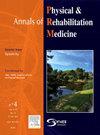康复期间的心肺运动与卒中后早期功能恢复的改善有关:一项队列研究
IF 4.6
3区 医学
Q1 REHABILITATION
Annals of Physical and Rehabilitation Medicine
Pub Date : 2025-08-16
DOI:10.1016/j.rehab.2025.102006
引用次数: 0
摘要
脑卒中后早期进行心肺运动(CRE)可以改善心肺功能,促进康复,促进神经可塑性。目的:本研究旨在确定常规住院卒中康复期间的CRE是否与运动和认知功能、功能性行走和运动损伤的改善恢复有关。方法将在2家康复医院住院14个月以上的503例患者纳入队列研究。参与者被分为3组:“处方”组,参与者完成CRE,包括在他们的治疗计划中;“偶然的”,他们完成了不包括在治疗计划中的CRE;和“没有”,他们没有完成任何CRE。协方差分析比较功能独立测量(FIM)、功能活动分类(FAC)和Chedoke-McMaster卒中评估(CMSA)两组出院时的评分,控制年龄、住院时间、合并症和基线评分。多元线性回归确定了康复期间进行CRE的时间与入院至出院时FIM、FAC和CMSA评分变化之间的关系,控制了年龄、住院时间、合并症和地点。结果处方组出院时FIM总分和运动分值均高于无处方组(A点;P & lt;0.001)或偶发组(Site B;P & lt;0.03)。在康复期间进行CRE的时间与所有结果的变化之间存在显著的正相关(r >;0.15), CMSA手评分除外。结论研究结果支持卒中后早期常规住院康复期间的CRE与功能独立性、行走和运动恢复的改善有关。然而,考虑到观察设计限制了因果推断,需要对照研究来证实CRE在中风后早期的益处。本文章由计算机程序翻译,如有差异,请以英文原文为准。
Cardiorespiratory exercise during rehabilitation is associated with improved functional recovery early post-stroke: A cohort study
Background
Cardiorespiratory exercise (CRE) early post-stroke can improve cardiorespiratory fitness, facilitate participation in rehabilitation, and promote neuroplasticity.
Objectives
This study aimed to determine if CRE during routine inpatient stroke rehabilitation is associated with improved recovery of motor and cognitive function, functional ambulation, and motor impairment.
Methods
People (n = 503) admitted to 2 rehabilitation hospitals over 14 months were included in this cohort study. Participants were classified into 3 groups: “Prescribed,” where participants completed CRE that was included in their treatment plan; “Incidental,” where they completed CRE that was not included in their treatment plan; and “None,” where they did not complete any CRE. Analysis of covariance compared Functional Independence Measure (FIM), Functional Ambulation Category (FAC), and Chedoke-McMaster Stroke Assessment (CMSA) scores between groups at discharge, controlling for age, length of stay, comorbidities and scores at baseline. Multiple linear regression determined the relationship between time spent doing CRE during rehabilitation and admission to discharge change in FIM, FAC and CMSA scores, controlling for age, length of stay, comorbidities, and site.
Results
The Prescribed group had higher FIM total and motor sub-scores at discharge than the None (Site A; P < 0.001) or the Incidental group (Site B; P < 0.03). There were significant positive correlations between time spent doing CRE during rehabilitation and change in all outcomes (r > 0.15), except CMSA hand scores.
Conclusions
Findings support that CRE during routine inpatient rehabilitation early post-stroke is associated with improved functional independence, ambulation and motor recovery. However, given that the observational design limits causal inferences, controlled studies are needed to confirm the benefits of CRE early post-stroke.
求助全文
通过发布文献求助,成功后即可免费获取论文全文。
去求助
来源期刊

Annals of Physical and Rehabilitation Medicine
Medicine-Rehabilitation
CiteScore
7.80
自引率
4.30%
发文量
136
审稿时长
34 days
期刊介绍:
Annals of Physical and Rehabilitation Medicine covers all areas of Rehabilitation and Physical Medicine; such as: methods of evaluation of motor, sensory, cognitive and visceral impairments; acute and chronic musculoskeletal disorders and pain; disabilities in adult and children ; processes of rehabilitation in orthopaedic, rhumatological, neurological, cardiovascular, pulmonary and urological diseases.
 求助内容:
求助内容: 应助结果提醒方式:
应助结果提醒方式:


